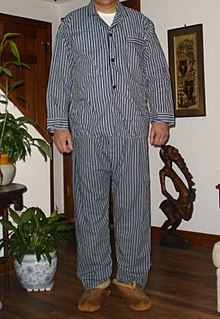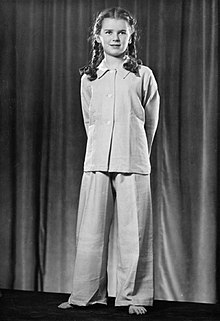Pajamas
Pajamas (US) or pyjamas (Commonwealth) (/pəˈdʒɑːməz, pɪ-, -ˈdʒæ-/), sometimes colloquially shortened to PJs,[1] jammies,[2] jam-jams, or in South Asia and South Africa, night suits are several related types of clothing worn as nightwear or while lounging or performing remote work from home. Pajamas are soft, warm, and traditionally loose garments derived from the Indian and Persian bottom-wear, the pyjamas. They originated in South Asia and were adopted in the Western world.
Etymology[edit]
The word pyjama was borrowed into English c. 1800 from the Hindustani pāy-jāmaਪਜਾਮਾ, itself borrowed from Persian: پايجامه, romanized: pāy-jāma, lit. 'leg-garment'.[3][4] The original pyjāmā are loose, lightweight trousers fitted with drawstring waistbands and worn by many Indian Sikhs, as well as Muslims and Hindus,[5][6] and later adopted by Europeans during British East India Company rule in India.[7]
History[edit]
The worldwide use of pajamas (the word and the clothing) outside the subcontinent is the result of adoption by British colonists in India in the 18th and 19th centuries, and the British influence on the wider Western world during the Victorian era. Pajamas had been introduced to England as "lounging attire" as early as the seventeenth century, then known as mogul's breeches (Beaumont and Fletcher) but they soon fell out of fashion. The word pajama (as pai jamahs, Paee-jams and variants) is recorded in English use in the first half of the nineteenth century. They did not become a fashion in Britain and the Western world as sleeping attire for men until the Victorian period, from about 1870.[8]
Hobson-Jobson: A Glossary of Colloquial Anglo-Indian Words and Phrases (1886) summarizes the state of usage at the time (s.v. "pyjammas"):
Types[edit]
Traditional[edit]
Traditional pajamas consist of a shirt-and-trousers combination made of soft fabric, such as flannel or lightweight cotton. The shirt element usually has a placket front and sleeves with no cuffs.
Pajamas are usually worn as nightwear with bare feet and without undergarments. They are often worn for comfort by people in their homes, especially by children, especially on the weekend.
Contemporary[edit]
Contemporary pajamas are derived from traditional pajamas. There are many variations in style such as short sleeve pajamas, pajama bottoms of varying length,[10] and pajamas incorporating various non-traditional materials. Often, people of both sexes opt to sleep or lounge in just pajama pants, usually with a t-shirt. For this reason, pajama pants are often sold as separates. Stretch-knit sleep apparel with rib-knit trimmings are common, mostly with young children.
Although pajamas are usually distinguished from one-piece sleeping garments such as nightgowns, in the US, they have sometimes included the latter or a somewhat shorter nightshirt as a top. Some pajamas feature a drop seat (also known as a trap door or butt flap): a buttoned opening in the seat, designed to allow the wearer to conveniently use a toilet.
Fire safety[edit]
In the United States, pajamas for children are required to comply with fire safety regulations. If made of flammable fabric, such as cotton, they must be tight fitting. Loose-fitting pajamas must be treated with a fire retardant.[11] Regulations in the United Kingdom are less stringent; pajamas which do not comply with fire safety standards may be sold, but must be labelled "KEEP AWAY FROM FIRE".[12]
Society and culture[edit]
Pajamas in the Western world have been regarded as essentially indoors wear, or wear for the home, whether treated as daywear or nightwear.
When Bette Davis wore her husband's pajama top as a nightie in the 1942 film Old Acquaintance, it caused a fashion revolution, with I. Magnin selling out of men’s sleepwear the morning after the movie opened, and all of it to young women.[13]
Since the late 20th century some people, in particular those in the US and to some extent Britain, Ireland, Australia, and New Zealand, have worn pajamas in public for convenience or as a fashion statement.[14][15]
One reason for the increased wearing of pajamas in public is that people no longer face the same social pressure as in the past.[16]
In January 2007, the gulf emirate Ras Al Khaimah, UAE introduced a strict dress code for all local government workers forbidding them from wearing pajamas to work.[17]
In January 2010, the Tesco supermarket in St Mellons, Cardiff, United Kingdom, started a ban on customers wearing pajamas.[18]
In May 2010, Shanghai discouraged the wearing of pajamas in public during Expo 2010.[19]
In January 2012, a local Dublin branch of the Government's Department of Social Protection advised that pajamas were not regarded as appropriate attire for clients attending the office for welfare services.[20]
Many school and work dress codes do not allow pajamas. In 2020, due to the COVID-19 pandemic, an Illinois school district set remote learning guidelines which state that pajamas should not be worn while studying remotely and students should follow the same dress code as they normally would at school.[21][22]
Schools sometimes designate a "pajama day" when students and staff come to school in their pajamas to boost school spirit.[23]
For a long part of the 20th and even the early 21st, ie. even in the 2010s, both men and women are often seen wearing pajamas as night wear on TV and in motion pictures. The main reason is that this is seen as more proper (less provocative or enticing) than other forms of underwear. It is most commonly seen as pants (trousers) combined with either a t-shirt or a shirt.[citation needed]







0 Komentar